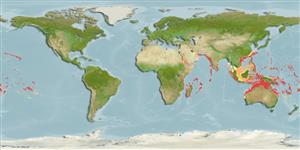>
Acanthuriformes (Surgeonfishes) >
Chaetodontidae (Butterflyfishes)
Etymology: Forcipiger: Latin, forceps = instrument of the pincers kind used for seizing and holding objects, esp. In surgical and obstetric operations + latin, gero = to carry; 1634 (Ref. 45335).
Issue
The species Forcipiger cyrano Randall, 1961 is considered as valid in Eschmeyer (CofF ver. Mar. 2011: Ref. 86697) following Randall (2007: Ref. 86689).
Environment: milieu / climate zone / depth range / distribution range
Ökologie
seewasser riff-verbunden; standorttreu; tiefenbereich 0 - 200 m (Ref. 89972). Tropical; 28°N - 28°S, 32°E - 130°W
Indo-Pacific: East Africa to the Hawaiian, Marquesan, and Pitcairn islands, north to the Bonin [=Ogasawara] Islands, south to New Caledonia and the Austral Islands; throughout Micronesia.
Size / Gewicht / Alter
Maturity: Lm ? range ? - ? cm
Max length : 22.0 cm TL Männchen/unbestimmt; (Ref. 9710)
Rückenflossenstacheln (insgesamt) : 10 - 11; Rückenflossenweichstrahlen (insgesamt) : 24 - 28; Afterflossenstacheln: 3; Afterflossenweichstrahlen: 17 - 20.
A generally uncommon species that inhabits seaward reefs to depths greater than 60 m (Ref. 9710). Benthopelagic (Ref. 58302). Feeds mainly on whole organisms such as small crustaceans. Usually seen in pairs. Oviparous (Ref. 205), monogamous (Ref. 52884). Forms pairs during breeding (Ref. 205). Sometimes dark brown instead of yellow (Ref. 48636). In the East Indian region this species is replaced by F. wanai at Cenderawasih Bay (Ref. 90102). Minimum depth reported taken from Ref. 128797.
Life cycle and mating behavior
Maturities | Fortpflanzung | Spawnings | Egg(s) | Fecundities | Larven
Distinct pairing (Ref. 205). Monogamous mating is observed as both obligate and social (Ref. 52884).
Myers, R.F., 1991. Micronesian reef fishes. Second Ed. Coral Graphics, Barrigada, Guam. 298 p. (Ref. 1602)
IUCN Rote Liste Status (Ref. 130435)
Bedrohung für Menschen
Harmless
Nutzung durch Menschen
Fischereien: weniger kommerziell; Aquarium: Kommerziell
Tools
Zusatzinformationen
Download XML
Internet Quellen
Estimates based on models
Preferred temperature (Ref.
123201): 24.7 - 29, mean 27.9 °C (based on 992 cells).
Phylogenetic diversity index (Ref.
82804): PD
50 = 0.6250 [Uniqueness, from 0.5 = low to 2.0 = high].
Bayesian length-weight: a=0.02291 (0.01212 - 0.04329), b=3.02 (2.86 - 3.18), in cm total length, based on LWR estimates for this species & (Sub)family-body (Ref.
93245).
Trophic level (Ref.
69278): 3.5 ±0.50 se; based on food items.
Widerstandsfähigkeit (Ref.
120179): hoch, Verdopplung der Population dauert weniger als 15 Monate. (Preliminary K or Fecundity.).
Fishing Vulnerability (Ref.
59153): Low vulnerability (12 of 100).
Nutrients (Ref.
124155): Calcium = 73 [37, 118] mg/100g; Iron = 0.713 [0.418, 1.163] mg/100g; Protein = 18.7 [17.5, 19.8] %; Omega3 = 0.141 [0.084, 0.234] g/100g; Selenium = 45.9 [25.1, 84.4] μg/100g; VitaminA = 47.7 [13.6, 165.1] μg/100g; Zinc = 1.14 [0.78, 1.63] mg/100g (wet weight);
